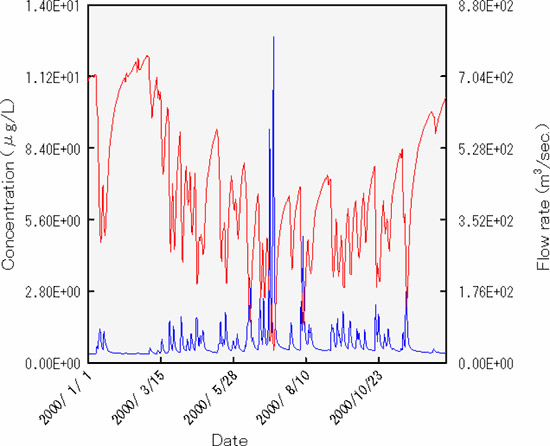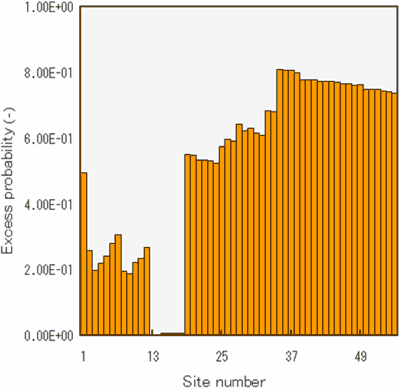- Applicable to Ecological Risk Assessment and Assessment of Emission Reduction Measures -
The research center for Chemical Risk Management (CRM) of the National Institute of Advanced Industrial Science and Technology (AIST), an independent administrative institution, has developed a software tool for chemical risk assessment in river basin and evaluation of emission reduction measures, named "AIST-Standardized Hydrology-based AssessmeNt tool for chemical Exposure Load (AIST- SHANEL)".
Recently, environmental pollution with chemical substances suspected of damaging human health and ecological system has been growing to serious social problems. Particularly, the information of exposure concentration of chemical substances with toxicity to aquatic organisms in river basin is not adequately known because of limited number of observation sites and sampling periods, and it is often very difficult to assess their impacts to the ecological system.
As the Pollutant Release and Transfer Register (PRTR) scheme has been enacted since fiscal 2001, where firms handling chemicals emitted into the environment are requested to report emission quantity, the emission data have become readily available to the general public. However, there has been no tool computing the exposure concentrations of chemicals in river basin from the PRTR release data.
The CRM-AIST has developed the user-friendly model to estimate daily exposure concentration at 1-km mesh by utilizing PRTR emission data, climatic, geographical, sewage and industrial statistics in the river basin concerned. With this model, it has become possible to easily obtain information about sites of outstanding emission in the river basin, some relationships between emission level, exposure concentrations and river flow rate.
Furthermore, the impact to the ecological system, and hence, the ecological risk can be assessed by estimating the probability of exceeding a threshold concentration affecting aquatic organisms. Should there be a substantial need for reducing the ecological risk, it would be possible to estimate, through simple data input, how the exposure concentration of chemicals is changed by reducing of emission from industry and the improvement of sewage removal efficiency.
This research will open the way to solve the problem what measures to take for industries releasing chemicals, local municipalities managing the river basin, as well as the general public concerned of the ecological risk.
The subsequent efforts will be paid to the model extension to Japanese major river basins and small river basins where the exposure concentration is readily affected by local emission, and the revised version of software will be released as AIST-SHANEL Version 1.0.
The release of chemical substances affecting the environment has been becoming an object of public concern. For instance, nonylphenol ethoxylate used as surfactant in the industrial detergent is mostly released into the water system, to be decomposed to nonylphenol which affects the aquatic organisms.
The CRM-AIST has been engaged since fiscal 2001 in studies on whether or not populations of the Japanese killifish are affected by nonylphenol distributed in the water system, and what risk reduction measures are required for conserving the ecological system. As little data are available on nonylphenol in the water system, a model has been needed for estimating the exposure concentration of concern. With the existing exposure models, it has not been possible to presume from what sources the chemical is released, and what proportion of it is processed at the sewage-disposal plant and to obtain the relationship between the emission sources and the exposure concentrations. Therefore, the development of a new model has been needed to estimate spatial distribution of the emission and the exposure concentration in river basins and to evaluate how the concentrations vary as the flow rate changes.
The present study has been carried out as a part of a contract R&D project "Risk Evaluation, Development of Risk Assessment Method and Analysis of Risk Reducing Effect of Control Measures" entrusted form the New Energy and Industrial Technology Development Organization (NEDO), another independent administrative institution. The CRM-AIST has already released two environmental exposure models for assessing risk of chemicals: AIST- Atmospheric Diffusion Model for Exposure Risk (AIST-ADMER) and AIST-Risk Assessment Model for Tokyo Bay (AIST-RAMTB).
In fiscal 2002, the development of river basin exposure analysis model taking into consideration of emission, river flow rate, sewerage, land use and other geographical data was started, and river basin exposure analysis models for the Tama River Basin, the Kanto Plain and the Yodogawa River Basin were developed. In fiscal 2003, the exposure analysis model for four river basins including the Tama River Basin was interfaced, and in fiscal 2004, the AIST-Standardized Hydrology-based AssessmeNt tool for chemical Exposure Level (AIST-SHANEL) Ver. 0.8 was completed.
The AIST-SHANEL Ver. 0.8 consists of two models: "SHANEL" to estimate river flow rate, emission amount, exposure concentration for the Tama River Basin (Tokyo, Kanagawa), the Nikko River Basin (Aichi), the Daishoji River Basin (Ishikawa) and the Ishizu River Basin (Osaka) at spatial resolution of 1 x 1 km mesh, every day, and "Turbo-SHANEL" to evaluate the order of magnitude of exposure concentration in chemicals for any river basin. The configuration of the AIST-SHANEL Ver. 0.8 is shown in Fig. 1.
 |
Fig. 1 Configuration of the AIST-SHANEL Ver. 0.8 |
The SHANEL is a dynamic analysis model with mass transfer mechanism, such as desorption to suspended solids in river water, adsorption to soil, settling and resuspension of suspended solids between the river water and sediment, which enable to estimate exposure concentrations of chemicals readily accumulated in river sediment and soil. Besides, it includes qualitative verifying functions of run-off load and mass balance. This model allows obtaining spatial distributions of direct emission amounts into river and emission from sewage treatment plants, and predicting areas and timings of enhanced exposure concentrations of the chemicals. For instance, you may see whether or not the exposure concentrations is high at those sites where the emission amounts is massive, or whether the concentration is higher downstream of the treated sewage outlet, from the spatial distribution for the concentration of chemicals as shown in Fig. 2.1. In Fig. 2.2, the temporal variation of concentration at a fixed site is shown where you can see when the exposure concentration rises. Additionally, in terms of ecological risk assessment, the probability of exposure concentration exceeding a threshold for affecting the aquatic organisms can be estimated as shown in Fig. 2.3. By using these results, it may be evaluated how far effective emission reduction measure and improvement of removal efficiency of sewage processing.
On the other hand, the Turbo-SHANEL makes it possible to provide the order of magnitude of exposure concentration of chemicals in fine weather over an entire river basin at once. The user can obtain the exposure concentration level in fine weather by simply entering the data of river basin area and the degree of urbanization, emission amounts in Japan and half-life of the chemical of interest.
To evaluate the reliability of the AIST-SHANEL Ver. 0.8, calculated value of exposure concentration was compared with observed value for nonylphenol ethoxylate, nonylphenol and alcohol ethoxylate. The former was found to be within the range of the latter, demonstrating that the model was verified for the exposure concentrations of these chemicals.
The AIST-SHANEL Ver. 0.8 has been designed user-friendly. The use of this model enables anyone to visualize the relationship between emission sources and exposure area in the river basin. The model has proved to be a useful tool for some industry trade to execute voluntary management for the emission amounts of chemicals, and for a local government to control the river basin quality. Furthermore, in the academia, the model may be useful as educational software for learning what the aquatic risk assessment is.
The CRM-AIST provides the AIST-SHANEL Ver. 0.8 in the form of CD-ROM free of charge. For how to apply, you can access the URL http://www.riskcenter.jp/SHANEL/.
The results of estimation of exposure concentrations of nonylphenol ethoxylate, nonylphenol and alcohol ethoxylate in the Tama River Basin, and the evaluation of some emission reduction measures were already reported at the Fourth World Congress of the Society of Environmental Toxicology and Chemistry (SETAC), November 18, 2004.
 |
Fig. 2.1. Spatial distribution of exposure concentration of nonylphenol ethoxylate at Tama River Basin area on December 31, 2000, showing the concentration increasing in the direction of downstream with little dilution. |
 |
Fig. 2.2. Temporal variation of exposure concentration of nonylphenol ethoxylate and river rate flow at the lowest reach of the stream in the Tama River in 2000. Blue represents the flow rate, and red exposure level. Peaks in the flow rate indicate heavy rainfall. |
 |
Fig. 2.3. Probability of nonylphenol ethoxylate exposure concentration exceeding 5.0 mg/m3 from the upper stream to the lower stream of the Tama River. The probability represents the percentage of days when the exposure level of this chemical exceeds the reference value of this chemical. The higher the probability is, the greater the risk is. |